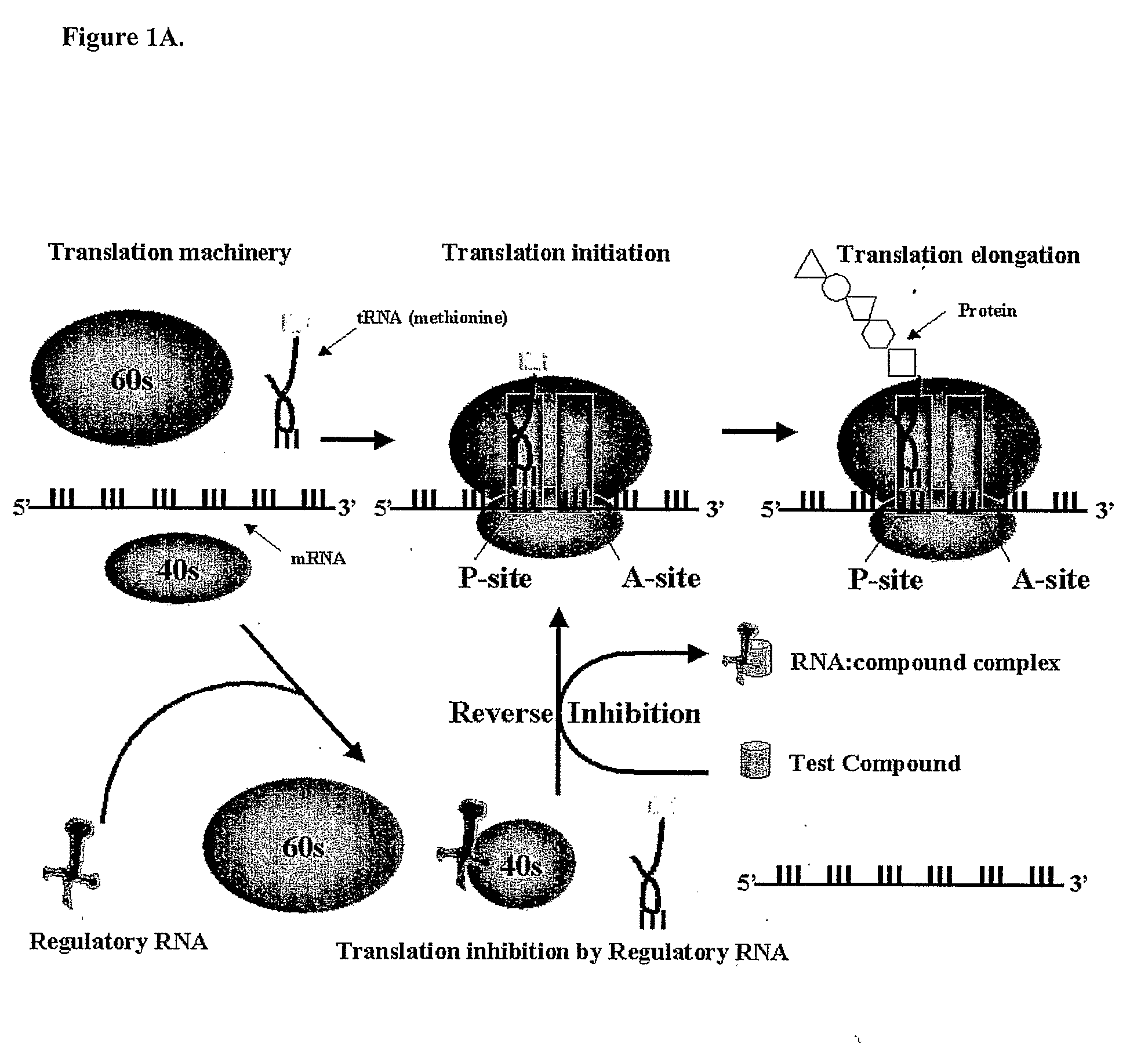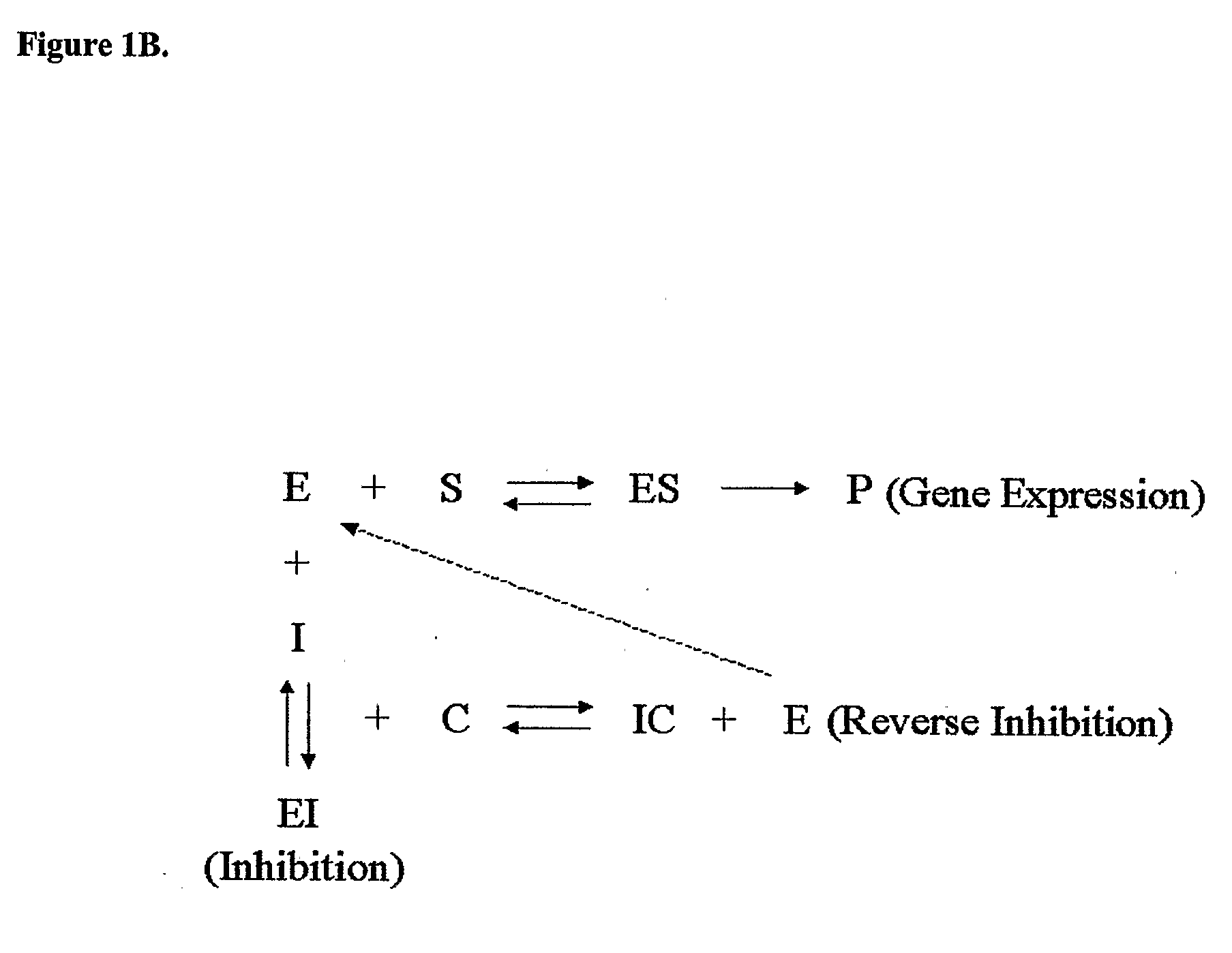Cell Based Methods And Systems For The Identification Of Rna Regulatory Sequences And Compounds That Modulate Their Functions
- Summary
- Abstract
- Description
- Claims
- Application Information
AI Technical Summary
Benefits of technology
Problems solved by technology
Method used
Image
Examples
example 1
Construction of the Reporter mRNA
[0122]This example illustrates the construction of the reporter mRNA to determine the level of reverse inhibition of translation. The reporter plasmid pT7 is constructed to contain the following elements: T7 promoter sequence and multiple cloning site (MCS). The non-natural MCS sequences used for the initial insertion of the Luciferase open reading frame (ORF) can also be used for generating fusion proteins. The plasmid pT7-luc contains the protein coding sequence of firefly luciferase cloned downstream of the T7 promoter sequence at the NcoI and BglII restriction endonuclease sites.
[0123]FIG. 3 shows the components of an exemplary reporter DNA construct used to produce reporter mRNA for use in the methods of the present invention, a description for which is in the Brief Description of the Drawings. The plasmid pT7-luc was digested with BamH1, which cuts downstream of the firefly luciferase coding sequence, to generate the linear DNA template used fo...
example 2
Construction of Inhibitory RNA Fragments
[0125]The plasmid pGEM3-HCV2b-IRES contains sequence coding for nucleotides 18 to 356 (SEQ ID NO: 1) of HCV-IRES RNA (genotype 2b) inserted at the BamHI restriction endonuclease site of the cloning vector pGEM-3 (Promega Corp., Madison, Wis.; FIG. 2A). RNA secondary structure prediction algorithms, as well as biochemical and genetic data, support a representation of this sequence as shown in FIG. 2B. Domains II-IV of the HCV-IRES have been reported to be necessary and sufficient to facilitate internal ribosome entry through recruitment of translational initiation factors. Thus, this RNA sequence, as well as fragments thereof, is used to inhibit translation of luciferase enzyme from reporter mRNA. To generate RNA fragments, primers complementary to sequences between structured regions were prepared, with 5′ forward primers designed to place a T7 promoter sequence (taatacgactcactatagg) upstream of the sequence of interest for use in run-off tran...
example 3
Determining the Inhibitory Activity of an RNA Test Sequence
Method A
[0128]This example provides a protocol for determining the inhibitory activity of an RNA test sequence derived from the UTR of HCV (e.g., HCV IRES III RNA), which contains a well-characterized IRES RNA regulatory element.
[0129]The day prior to RNA transfection with an RNA test sequence (Example 2), adherent COS-1 cells are seeded in culture wells of 6-well plates at a density of 3×105 cells per well in 2 ml of growth medium containing serum and antibiotics. The cells are incubated at 37° C. and 5% CO2 in the growth medium overnight.
[0130]The cells are next transfected with RNA using a Trans Messenger Transfection Reagent in conjunction with a specific RNA-condensing reagent (Enhancer R) and an RNA-condensing buffer (Buffer EC-R) available from Qiagen (Valencia, Calif.). Transfection is performed according to a modified procedure based on the manufacturer's protocol. The enhancer first condenses the RNA molecules and ...
PUM
| Property | Measurement | Unit |
|---|---|---|
| Cell death | aaaaa | aaaaa |
| Gene expression profile | aaaaa | aaaaa |
| Fluorescence | aaaaa | aaaaa |
Abstract
Description
Claims
Application Information
 Login to View More
Login to View More - R&D
- Intellectual Property
- Life Sciences
- Materials
- Tech Scout
- Unparalleled Data Quality
- Higher Quality Content
- 60% Fewer Hallucinations
Browse by: Latest US Patents, China's latest patents, Technical Efficacy Thesaurus, Application Domain, Technology Topic, Popular Technical Reports.
© 2025 PatSnap. All rights reserved.Legal|Privacy policy|Modern Slavery Act Transparency Statement|Sitemap|About US| Contact US: help@patsnap.com



